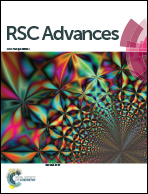Isoindigo-based microporous organic polymers for carbon dioxide capture†
Abstract
Isoindigo-based microporous organic polymers from nitrogen- and oxygen-rich 6,6′-dibromoisoindigo and its alkylated derivatives have been synthesized via a palladium-catalyzed Sonogashira–Hagihara cross-coupling reaction. The pore properties (pore size & surface area) of this kind of microporous organic polymers could be tuned by the alkyl groups connected to the 6,6′-dibromoisoindigo unit. Owing to the incorporation of nitrogen atoms and ketonic groups from the isoindigo unit into the skeleton of the microporous polymers, enhancing the binding affinity between the pore wall and CO2 molecules, the polymers show high isosteric heats of CO2 adsorption of 27.4–33.5 kJ mol−1, which are higher than those of many reported porous organic polymers. Compared with the alkylated polymers of TBMIDM and TBMIDE, TBMID without an alkyl group exhibits a high CO2 uptake ability of 3.30 mmol g−1 (1.13 bar/273 K) with a CO2/N2 sorption selectivity of 58.8 : 1, because of the strong interactions between the polymer network and the polarizable CO2 molecules through dipole–quadrupole interactions and/or hydrogen bonding. These data demonstrate that these isoindigo-based microporous organic polymers could be potential candidates for applications in post-combustion CO2 capture and sequestration.


 Please wait while we load your content...
Please wait while we load your content...